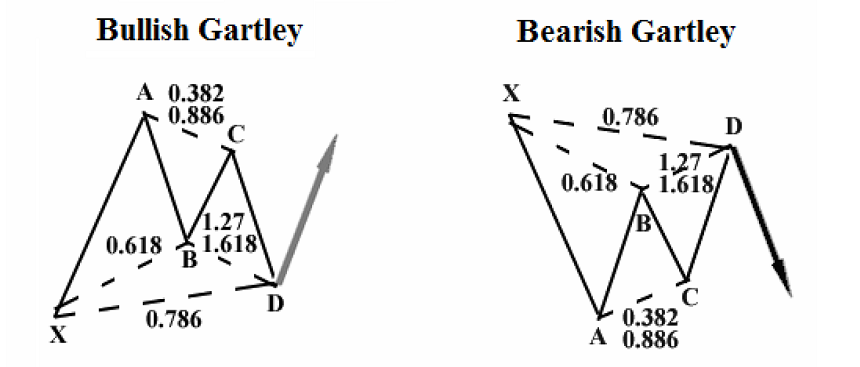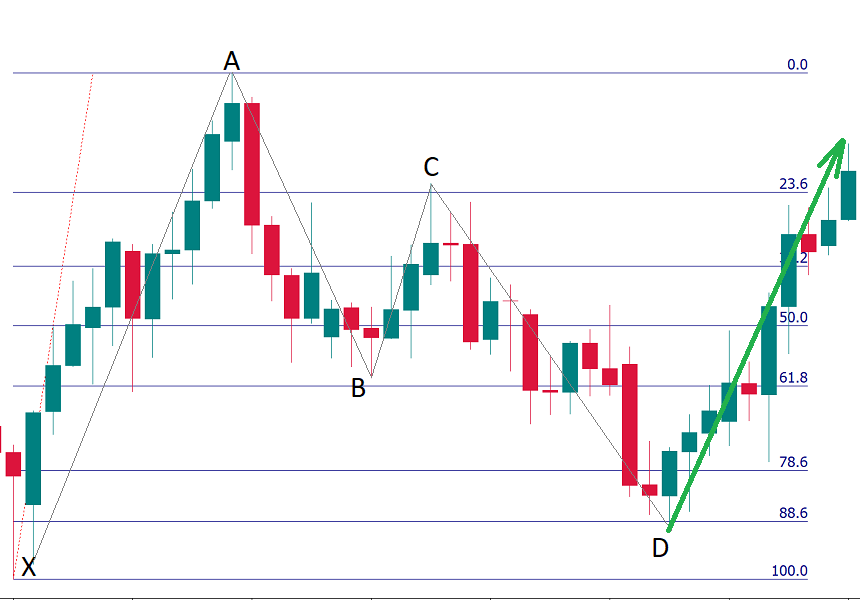Gartley
Esta información no son consejos para inversión
El patrón de Gartley es el patrón armónico más antiguo reconocido. Fue desarrollado y nombrado por el mismo H.M. Gartley. Sin embargo, Gartley no hizo mención a los ratios de Fibonacci para el patrón. Los niveles de Fibonacci fueron agregados después por Scott Carney y Larry Pesavento.
Los patrones de Gartley incluyen el patrón básico ABCD que está precedido por un máximo o mínimo significativo. Así, el patrón de Gartley está formado por 4 swings del precio. El patrón alcista de Gartley parece similar a una letra M, mientras que el bajista se parece a una W. Las letras para marcar un patrón de Gartley en la tabla son XABCD. La línea XA debe ser la línea más larga del patrón.
Estudiemos el patrón alcista de Gartley (el bajista es su espejo).

Todo comienza en el punto X que puede ser encontrado en una temporalidad mayor y ser parte de una tendencia más grande. Es un mínimo/máximo que es muy distinto y evidente para todos los que están mirando el gráfico. Luego, el precio sube de X a A y hace reversión en A. La pata XA limita el alcance del patrón, y sus otras patas deberían desarrollarse dentro de estos puntos.
Un patrón con la estructura como se muestra en la imagen puede ser llamado patrón de Gartley si se ajusta a las siguientes reglas:
- El punto B está en el 61.8% de retroceso de XA. Esta es la condición más importante.
- El punto C puede estar en el 38.2% -88.6% de retroceso de AB.
- El punto D se puede encontrar en la extensión 127.2% -161.8% de AB o en el retroceso de 78.6% de XA.
Cómo operar
El punto D es el disparador para comprar en un patrón alcista de Gartley. Observa que el punto D es una potencial zona de reversión. Los traders necesitarán una confirmación de una reversión real en esta área. La confirmación puede venir en forma de un patrón de reversión de velas o de lecturas de indicadores técnicos.
Take Profit y Stop Loss
Aquí están las opciones para una orden Take Profit.
TP1: 61.8% de CD
TP2: el tamaño de XA proyectado desde D
Se puede colocar un Stop Loss debajo de X para un Gartley alcista (arriba de X para un Gartley bajista) o según tus reglas de gestión de riesgos.
Ten en cuenta que en la vida real, los patrones que se encuentran en los gráficos a menudo no se ajustan perfectamente a los ratios enumerados anteriormente. Como resultado, cuanto mayor sea la diferencia entre el patrón de Gartley del libro de texto y el patrón que deseas operar, debe tenerse en cuenta el mayor riesgo de error.
Así es como se ve un patrón de Gartley en el gráfico. El punto B está en aproximadamente el 61.8% de retroceso de XA. El punto C está en el 61.8% de retroceso de AB. El punto D se encuentra en el 88.6% de retroceso de XA. El patrón no es perfecto para los libros de texto, pero se acerca bastante.

Conclusión
Un patrón de Gartley correctamente identificado ofrece una operación con un nivel de riesgo bajo. En muchos casos, los patrones de Gartley se forman cerca de los techos/pisos del mercado y preceden a una reversión. Puedes encontrar y operar patrones de Gartley en todas las temporalidades.
Otros artículos en esta sección
- Estructura de un Robot de Trading
- Construyendo un Robot de Trading sin Programar
- ¿Cómo Lanzar Robots de Trading en MetaTrader 5?
- Trading algorítmico: ¿de qué se trata?
- Trading algorítmico con MQL5
- ¿Qué significa "truncamiento"?
- Ichimoku
- Patrón Diagonal Inicial
- Patrón de Ondas de Wolfe
- Patrón de Tres Impulsos
- Tiburón
- Mariposa
- Cangrejo
- Murciélago
- ABCD
- Patrones Armónicos
- Introducción al análisis de las Ondas de Elliott
- Cómo operar los rompimientos
- Trading de Forex noticias
- ¿Cómo colocar una orden Take Profit?
- Gestión de riesgos
- ¿Cómo colocar una orden Stop Loss?
- Indicadores técnicos: operando divergencias












